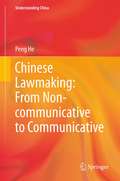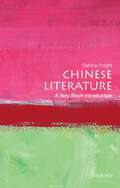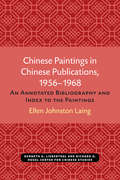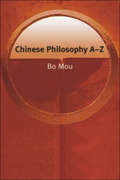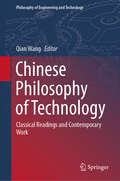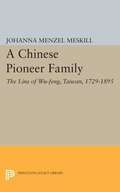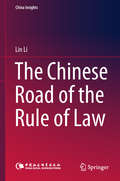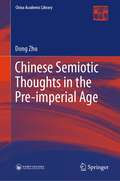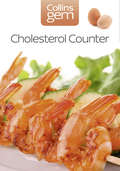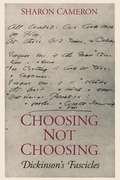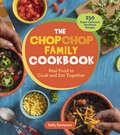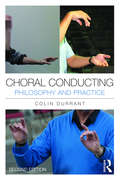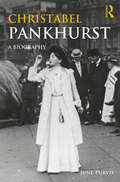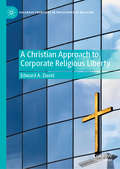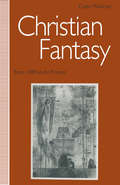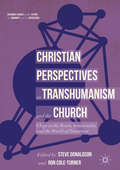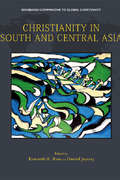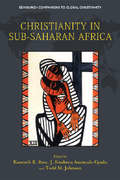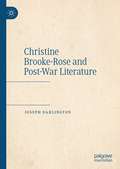- Table View
- List View
Chinese Lawmaking: From Non-communicative To Communicative (Understanding China)
by Peng HeDr Peng He in her book addresses various issues, drawing on Western and Chinese sources for her argument for a ‘communicative’ theory of law making. This book is both timely and important in the Chinese context. Her argument depends upon the insight that what is important in societies is not just representative democracy but ‘voice’ - the opportunity for individuals to be heard and bring their input into official systems. More than that, she argues that this can also take further the idea of living by the rules as something that is not to be seen as narrow Legalism but as something more akin to living ‘righteously’ – a view which is resonant with parts of Chinese legal thought. This book is also important in the present Chinese context in another way. The developing economy necessitates substantial legal reform. But applying Western models to China can often be naïve and not fully fulfil their intended purpose. Peng He’s work addresses this by looking at the process of legislation in connection with legal reform. It is grounded in a sound theoretical reflection of both the process of legal transplantation and the process of law making, and looks both at Western and Chinese sources. Such an approach needs to draw from several intellectual traditions and it is this interdisciplinary, foundational research that is the task Dr He has set herself in her project. Her theory will provide an abstract theoretical framework that is sensitive to local conditions, while at the same time incorporating insights on law reform from a broad range of disciplines. Her research is of direct practical relevance for reforming the legislative process in China. ——Professor Zenon Bańkowski The University of Edinburgh
Chinese Literature: Chinese Literature: A Very Short Introduction (Very Short Introductions)
by Sabina KnightPerhaps nowhere else has literature been as conscious a collective endeavor as in China, and China's survival over three thousand years may owe more to its literary traditions than to its political history. This Very Short Introduction tells the story of Chinese literature from antiquity to the present, focusing on the key role literary culture played in supporting social and political concerns. Embracing traditional Chinese understandings of literature as encompassing history and philosophy as well as poetry and poetics, storytelling, drama, and the novel, Sabina Knight discusses the philosophical foundations of literary culture as well as literature's power to address historical trauma and cultivate moral and sensual passions. From ancient historical records through the modernization and globalization of Chinese literature, Knight draws on lively examples to underscore the close relationship between ethics and aesthetics, as well as the diversity of Chinese thought. Knight also illuminates the role of elite patronage; the ways literature has served the interests of specific groups; and questions of canonization, language, nationalism, and cross-cultural understanding. The book includes Chinese characters for names, titles, and key terms.
Chinese Literature: A Very Short Introduction (Very Short Introductions)
by Sabina KnightPerhaps nowhere else has literature been as conscious a collective endeavor as in China, and China's survival over three thousand years may owe more to its literary traditions than to its political history. This Very Short Introduction tells the story of Chinese literature from antiquity to the present, focusing on the key role literary culture played in supporting social and political concerns. Embracing traditional Chinese understandings of literature as encompassing history and philosophy as well as poetry and poetics, storytelling, drama, and the novel, Sabina Knight discusses the philosophical foundations of literary culture as well as literature's power to address historical trauma and cultivate moral and sensual passions. From ancient historical records through the modernization and globalization of Chinese literature, Knight draws on lively examples to underscore the close relationship between ethics and aesthetics, as well as the diversity of Chinese thought. Knight also illuminates the role of elite patronage; the ways literature has served the interests of specific groups; and questions of canonization, language, nationalism, and cross-cultural understanding. The book includes Chinese characters for names, titles, and key terms.
Chinese Paintings in Chinese Publications, 1956–1968: An Annotated Bibliography and Index to the Paintings (Michigan Monographs In Chinese Studies #6)
by Ellen Johnston LaingThis bibliography includes publications issued between 1956 and August 1968 that reproduce Chinese paintings now in Chinese public or private collections. The great majority of these publications were produced in Mainland China, Taiwan, Hong Kong, or Japan. Each publication included in the bibliography has been provided with a detailed physical description of the publication itself: the amounts of text , the number of plates in color and in monochrome, and a general evaluation of the quality of the reproductions. The title by which each work is referred to in the index is included at the end of each entry.
Chinese Philosophy A†“Z (Philosophy A-Z)
by Bo MouA concise alphabetic guide to the main concepts, figures, topics and important movements of thought that have shaped Chinese philosophy over the last three thousand years.
Chinese Philosophy of Technology: Classical Readings and Contemporary Work (Philosophy of Engineering and Technology #34)
by Qian WangThis book gathers essays that introduce the ideological advances in the philosophy of engineering and technology in contemporary China. It particularly focuses on China’s distinctive concepts and methods, revealing different views and academic debates to offer readers a comprehensive overview of this important field.The contributors present unique perspectives based on practical problems and traditional philosophy, examining such issues and concepts as axiology and theories of process, the difference between engineering activities and technology activities, and the core of the relationship between “Dao” and “Technique.”Other essays cover the ethics of technology, practical wisdom (phronesis) and practical reasoning, as well as creative concepts and methods concerning the philosophical problems in high technology, architectural technology, and technological innovation. The authors also consider more general issues in the field.This book compiles the relevant research achievements of Chinese scholars in various time periods. Some authors have revised and translated into English papers published in Chinese, while others present their research in English specifically for this study. An annotated bibliography of the major publications in the field completes this collection.
A Chinese Pioneer Family: The Lins of Wu-feng, Taiwan, 1729-1895 (PDF)
by Johanna Margarete MeskillIn an absorbing account of a frontier family's rise to local eminence, from its pioneer days in eighteenth-century Taiwan through its attainment of gentry status there a century later, Johanna Meskill presents not just a family history but a social history of late imperial China as well.Originally published in 1987.The Princeton Legacy Library uses the latest print-on-demand technology to again make available previously out-of-print books from the distinguished backlist of Princeton University Press. These editions preserve the original texts of these important books while presenting them in durable paperback and hardcover editions. The goal of the Princeton Legacy Library is to vastly increase access to the rich scholarly heritage found in the thousands of books published by Princeton University Press since its founding in 1905.
The Chinese Road of the Rule of Law (China Insights)
by Lin LiThis book studies the practical experience and theoretical development of rule of law in China, and provides fundamental theory for the construction of rule of law in contemporary China. The author examines the rule of law by exploring the entire legal system, and highlighting various aspects including the legislation, law enforcement and supervision systems. Readers will also discover the author’s strong opinions on scientific legislation, legal government, judicial reform, and the culture of rule of law. This highly readable book will appeal to both general readers and researchers interested in rule of law in China.
Chinese Semiotic Thoughts in the Pre-imperial Age (China Academic Library)
by Dong ZhuThis book examines practices on the relationship between sign and meaning in the Pre-Imperial period of China from the semiotics perspective. Although the Chinese civilization did not develop a comprehensive semiotics system in that period, they are highly semiotic in many ways. The thinking and application of signs of Chinese people can be found in many classics, such as The Book of Changes, The Analects of Confucius, Tao De Jing and Zhuangzi. This book begins its study by re-examining the semiotic thoughts contained in The Book of Changes and inquiries into the thoughts of the major philosophers of different schools. It provides insights into the findings of these philosophers concerning the relationship between sign and meaning. In particular, it concentrates on how the prosperity of the various contending semiotic thoughts complemented each other in forming a sign system. In addition, the book also emphasizes the wholeness and associativity of observing things and studying relevant signs of Chinese people. As the first monograph in any language to systematically summarize Chinese semiotic thought in the Pre-Imperial period, this book helps promote understanding of the traditional Chinese culture and mindset.
Cholesterol Counter: Lower Cholesterol The Easy Way (Collins Gem)
by Kate SantonThis handy pick-up guide to cholesterol is unique, including listings of cholesterol counts for thousands of everyday food stuffs.
Choosing Not Choosing: Dickinson's Fascicles
by Sharon CameronAlthough Emily Dickinson copied and bound her poems into manuscript notebooks, in the century since her death her poems have been read as single lyrics with little or no regard for the context she created for them in her fascicles. Choosing Not Choosing is the first book-length consideration of the poems in their manuscript context. Sharon Cameron demonstrates that to read the poems with attention to their placement in the fascicles is to observe scenes and subjects unfolding between and among poems rather than to think of them as isolated riddles, enigmatic in both syntax and reference. Thus Choosing Not Choosing illustrates that the contextual sense of Dickinson is not the canonical sense of Dickinson. Considering the poems in the context of the fascicles, Cameron argues that an essential refusal of choice pervades all aspects of Dickinson's poetry. Because Dickinson never chose whether she wanted her poems read as single lyrics or in sequence (nor is it clear where any fascicle text ends, or even how, in context, a poem is bounded), "not choosing" is a textual issue; it is also a formal issue because Dickinson refused to chose among poetic variants; it is a thematic issue; and, finally, it is a philosophical one, since what is produced by "not choosing" is a radical indifference to difference. Extending the readings of Dickinson offered in her earlier book Lyric Time, Cameron continues to enlarge our understanding of the work of this singular American poet.
The ChopChop Family Cookbook: Real Food to Cook and Eat Together; 250 Super-Delicious, Nutritious Recipes
by Sally SampsonFrom the creators of the popular ChopChop Family magazine, this colorful cookbook features more than 250 recipes and cooking tips that make it fun and easy for families and kids to learn to cook and enjoy delicious, nutritious, affordable meals together.
Choral Conducting: Philosophy and Practice
by Colin DurrantChoral Conducting: Philosophy and Practice, Second Edition is an updated resource for conductors and singers alike, a college-level text for students of choral conducting that considers conducting and singing from a holistic perspective. This singer-friendly and voice-healthy approach examines the rehearsal environment alongside its musical performance counterpart. The author explores what is involved in leading a choral group, examining theories of learning and human behavior to understand the impact choral conductors have on the act of singing. Divided into two main parts—Philosophy and Practice—the text begins with an historical look at conducting, exploring questions of why people sing and why they sing together, and ultimately presents the application of this philosophy, showing how a conductor’s gestures and patterns can influence vocal outcomes. In addressing how singers learn and respond to choral music, as well as how conductors communicate with singers in rehearsal and performance, Choral Conducting turns an eye to learning how we learn and the role successful choral conductors play in motivating singers, developing healthy singing habits, and improving individual and ensemble vocal quality—all with the aims of enhancing musical understanding. New to this edition: Updated diagrams, photos, and musical examples Revised sample choral programs Increased consideration of the orchestral conductor A renewed focus on the intersections of learning, health and well-being, and the social perspective, supported by new and recent research
Choral Conducting: Philosophy and Practice
by Colin DurrantChoral Conducting: Philosophy and Practice, Second Edition is an updated resource for conductors and singers alike, a college-level text for students of choral conducting that considers conducting and singing from a holistic perspective. This singer-friendly and voice-healthy approach examines the rehearsal environment alongside its musical performance counterpart. The author explores what is involved in leading a choral group, examining theories of learning and human behavior to understand the impact choral conductors have on the act of singing. Divided into two main parts—Philosophy and Practice—the text begins with an historical look at conducting, exploring questions of why people sing and why they sing together, and ultimately presents the application of this philosophy, showing how a conductor’s gestures and patterns can influence vocal outcomes. In addressing how singers learn and respond to choral music, as well as how conductors communicate with singers in rehearsal and performance, Choral Conducting turns an eye to learning how we learn and the role successful choral conductors play in motivating singers, developing healthy singing habits, and improving individual and ensemble vocal quality—all with the aims of enhancing musical understanding. New to this edition: Updated diagrams, photos, and musical examples Revised sample choral programs Increased consideration of the orchestral conductor A renewed focus on the intersections of learning, health and well-being, and the social perspective, supported by new and recent research
Christabel Pankhurst: A Biography (Women's and Gender History)
by June PurvisTogether with her mother, Emmeline, Christabel Pankhurst co-led the single-sex Women’s Social and Political Union (WSPU), founded in 1903 and soon regarded as the most notorious of the groupings campaigning for the parliamentary vote for women. A First Class Honours Graduate in Law, the determined and charismatic Christabel, a captivating orator, revitalised the women’s suffrage campaign by rousing thousands of women to become suffragettes, as WSPU members were called, and to demand rather than ask politely for their democratic citizenship rights. A supreme tactician, her advocacy of ‘militant’, unladylike tactics shocked many people, and the political establishment. When an end to militancy was called on the outbreak of war in 1914, she encouraged women to engage in war work as a way to win their enfranchisement. Four years later, when enfranchisement was granted to certain categories of women aged thirty and over, she stood unsuccessfully for election to parliament, as a member of the Women’s Party. In 1940 she moved to the USA with her adopted daughter, and had a successful career there as a Second Adventist preacher and writer. However, she is mainly remembered for being the driving force behind the militant wing of the women’s suffrage movement. This full-length biography, the first for forty years, draws upon feminist approaches to biography writing to place her within a network of supportive female friendships. It is based upon an unrivalled range of previously untapped primary sources.
Christabel Pankhurst: A Biography (Women's and Gender History)
by June PurvisTogether with her mother, Emmeline, Christabel Pankhurst co-led the single-sex Women’s Social and Political Union (WSPU), founded in 1903 and soon regarded as the most notorious of the groupings campaigning for the parliamentary vote for women. A First Class Honours Graduate in Law, the determined and charismatic Christabel, a captivating orator, revitalised the women’s suffrage campaign by rousing thousands of women to become suffragettes, as WSPU members were called, and to demand rather than ask politely for their democratic citizenship rights. A supreme tactician, her advocacy of ‘militant’, unladylike tactics shocked many people, and the political establishment. When an end to militancy was called on the outbreak of war in 1914, she encouraged women to engage in war work as a way to win their enfranchisement. Four years later, when enfranchisement was granted to certain categories of women aged thirty and over, she stood unsuccessfully for election to parliament, as a member of the Women’s Party. In 1940 she moved to the USA with her adopted daughter, and had a successful career there as a Second Adventist preacher and writer. However, she is mainly remembered for being the driving force behind the militant wing of the women’s suffrage movement. This full-length biography, the first for forty years, draws upon feminist approaches to biography writing to place her within a network of supportive female friendships. It is based upon an unrivalled range of previously untapped primary sources.
A Christian Approach to Corporate Religious Liberty (Palgrave Frontiers in Philosophy of Religion)
by Edward A. DavidThis book addresses one of the most urgent issues in contemporary American law—namely, the logic and limits of extending free exercise rights to corporate entities. Pointing to the polarization that surrounds disputes like Burwell v. Hobby Lobby, David argues that such cases need not involve pitting flesh-and-blood individuals against the rights of so-called “corporate moral persons.” Instead, David proposes that such disputes should be resolved by attending to the moral quality of group actions. This approach shifts attention away from polarizing rights-talk and towards the virtues required for thriving civic communities. More radically, however, this approach suggests that groups themselves should not be viewed as things or “persons” in the first instance, but rather as occasions of coordinated activity. Discerned in the writings of Saint Thomas Aquinas, this reconceptualization helps illuminate the moral stakes of a novel—and controversial—form of religious freedom.
Christian Fantasy: From 1200 to the Present
by Colin N. ManloveThis is the first account of invented stories involving the Christian supernatural. In their development a central concern is found to be the fantasy-making human imagination itself, at first seen as a obstacle to Christian purpose, but more recently given freer rein.
Christian Perspectives on Transhumanism and the Church: Chips in the Brain, Immortality, and the World of Tomorrow (Palgrave Studies in the Future of Humanity and its Successors)
by Steve Donaldson Ron Cole-TurnerChristians have always been concerned with enhancement—now they are faced with significant questions about how technology can help or harm genuine spiritual transformation. What makes traditional and technological enhancement different from each other? Are there theological insights and spiritual practices that can help Christians face the challenge of living in a technological world without being dangerously conformed to its values? This book calls on Christians to understand and engage the deep issues facing the church in a technological, transhumanist future.
Christian Perspectives on Transhumanism and the Church: Chips in the Brain, Immortality, and the World of Tomorrow (Palgrave Studies in the Future of Humanity and its Successors)
by Steve Donaldson Ron Cole-TurnerChristians have always been concerned with enhancement—now they are faced with significant questions about how technology can help or harm genuine spiritual transformation. What makes traditional and technological enhancement different from each other? Are there theological insights and spiritual practices that can help Christians face the challenge of living in a technological world without being dangerously conformed to its values? This book calls on Christians to understand and engage the deep issues facing the church in a technological, transhumanist future.
Christianity in South and Central Asia (Edinburgh Companions to Global Christianity)
by Kenneth R. Ross Daniel Jeyaraj Todd M. JohnsonThis comprehensive reference volume covers every country in South and Central Asia, offering reliable demographic information and original interpretative essays by indigenous scholars and practitioners. It maps patterns of growth and decline, assesses major traditions and movements, analyses key themes and examines current trends.
Christianity in South and Central Asia (Edinburgh Companions to Global Christianity)
This comprehensive reference volume covers every country in South and Central Asia, offering reliable demographic information and original interpretative essays by indigenous scholars and practitioners. It maps patterns of growth and decline, assesses major traditions and movements, analyses key themes and examines current trends.
Christianity in Sub-Saharan Africa (Edinburgh Companions to Global Christianity)
by Kenneth Ross J. Kwabena Asamoah-GyaduThis comprehensive reference volume covers every country in Sub-Saharan Africa, offering reliable demographic information and original interpretative essays by indigenous scholars and practitioners. It maps patterns of growth and decline, assesses major traditions and movements, analyses key themes and examines current trends.
Christianity in Sub-Saharan Africa (Edinburgh Companions to Global Christianity)
by Kenneth Ross J. Kwabena Asamoah-GyaduThis comprehensive reference volume covers every country in Sub-Saharan Africa, offering reliable demographic information and original interpretative essays by indigenous scholars and practitioners. It maps patterns of growth and decline, assesses major traditions and movements, analyses key themes and examines current trends.
Christine Brooke-Rose and Post-War Literature
by Joseph DarlingtonThis book utilizes archive research, interviews and historical analysis to present a comprehensive overview of the works of Christine Brooke-Rose. A writer well-known for her idiosyncratic and experimental approaches to the novel form; this work traces her development from her early years as a social satirist, through her space-aged experimentalism in the 1960s, to her later poststructuralism and interest in digital computing and genetics. The book gives an overview of her writing and intellectual career with new archival research that places Brooke-Rose’s work in the context of the historically important events in which she was a participant: Bletchley Park codebreaking in the Second World War, the events in Paris during May 1968, the dawning of the internet and the rise of poststructuralism. Joseph Darlington begins with Brooke-Rose’s first novels written in the late 1950s of social satire, studies her experimental phase of writing and finally illuminates her unique approach to autobiography, arguing for reevaluating this interdisciplinary author and her contribution to poststructuralism, life writing and post-war literature.
